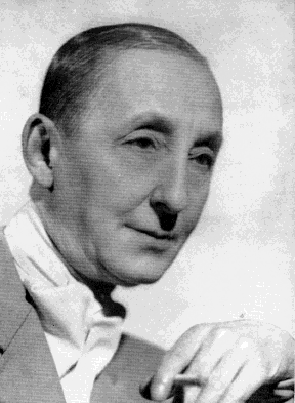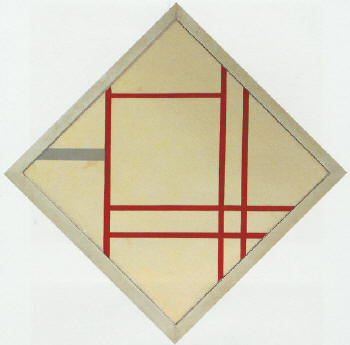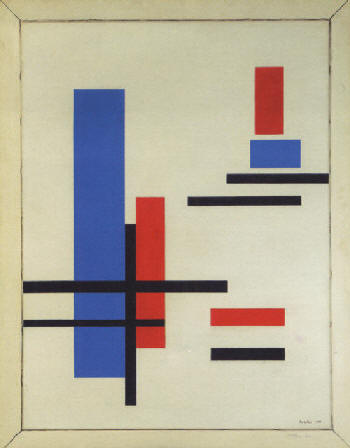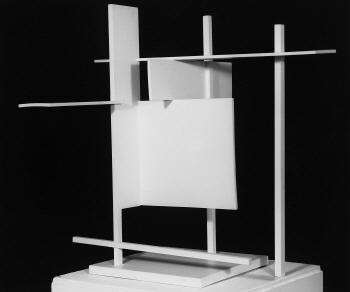|
Marlow Moss
Marjorie Jewel "Marlow" Moss (29 May 1889, London - 23
August 1958, Penzance) was a British Constructivist artist who worked in
painting and sculpture.
 Born
in Kilburn, she was the daughter of Lionel Moss, a master hosier and
clothier, and his wife Frannie Jacobs. Against the wishes of her family,
she chose to pursue an artistic career, studying at the St John's Wood
School of Art in 1916–17, then the Slade School of Fine Art. She left
the latter in 1919, probably due to a mental breakdown, to live alone in
Cornwall. Born
in Kilburn, she was the daughter of Lionel Moss, a master hosier and
clothier, and his wife Frannie Jacobs. Against the wishes of her family,
she chose to pursue an artistic career, studying at the St John's Wood
School of Art in 1916–17, then the Slade School of Fine Art. She left
the latter in 1919, probably due to a mental breakdown, to live alone in
Cornwall.
In 1923, inspired by a biography of Marie Curie, she was able to return
to London to study in the British Museum Reading Room, then studied
sculpture at the Penzance School of Art, before taking up painting and
setting up a London studio in 1926. At this point in her life she
permanently adopted a masculine appearance (short hair, cravat and
jodhpurs) and changed her forename to Marlow.
In 1927 she visited, and later moved to,
Paris where she met her lifelong partner, the Dutch writer A. H. Nijhoff
(Antoinette Hendrika Nijhoff-Wind, wife of the poet Martinus Nijhoff).
She was a pupil of Léger and Ozenfant at the Académie Moderne, but her
style was particularly influenced by Piet Mondrian. She was also
acquainted with Georges Vantongerloo and Jean Gorin. In Paris she was a
founder member of the Abstraction-Création association, and exhibited
with the Salon des Surindépendants.
 At
the beginning of World War II she left France to live near Lamorna Cove
in Cornwall, studying architecture at the Penzance School of Art. For
the rest of her life she lived and worked in Cornwall, frequently
visiting Paris. She joined the London branch of Group Espace and had
solo exhibitions at the Hanover Gallery in 1953 and 1958. At
the beginning of World War II she left France to live near Lamorna Cove
in Cornwall, studying architecture at the Penzance School of Art. For
the rest of her life she lived and worked in Cornwall, frequently
visiting Paris. She joined the London branch of Group Espace and had
solo exhibitions at the Hanover Gallery in 1953 and 1958.
She died of cancer in 1958, and her ashes
were scattered on the sea near Lamorna.
Her oeuvre spanned painting, sculpture and reliefs. Prior to World War
II her main medium was paint, in which she produced highly abstract
compositions simple black lines and grids akin to the Neo-Plasticism of
Mondrian, whose work she highly admired (some sources suggest that
Mondrian may have been influenced by her work, rather than vice versa).
Later in the 1930s she moved to all-white reliefs of wood, rope, and
string. Most of this pre-war work was destroyed, along with her French
studio, by Luftwaffe bombing.
 Post-war,
her architectural studies led her to develop sculptural and relief works
such as the 1956-7 Balanced Forms in Gun Metal on Cornish Granite, while
she continued to paint, developing a style structurally similar but more
colourful than early works. Post-war,
her architectural studies led her to develop sculptural and relief works
such as the 1956-7 Balanced Forms in Gun Metal on Cornish Granite, while
she continued to paint, developing a style structurally similar but more
colourful than early works.
Despite the innovative nature of her work, her early base in Paris and
later reclusive lifestyle led to a low-key reputation as a British
artist, and until the 1980s she was viewed as a minor Mondrian imitator.
Her works are now held at the Tate and the Henry Moore Institute.
 From
the Henry Moore Institute website: The
Henry Moore Institute is delighted to announce the recent acquisition of
Spatial Construction in Steel,
a work from 1956-7 by Marlow Moss (1890-1958). Moss is often overlooked
in the history of 20th century British sculpture, a disregard stemming
perhaps from the fact that she spent most of her career in Paris, where
she formed a warm and mutually edifying friendship with Piet Mondrian.
It is possibly because of this relationship with the great pioneer of
neo-plasticism that Moss is so admired today in Holland. Her work is
found in the permanent collections of the Kröller-Müller Museum and the
Haags Gemeentemuseum in the Hague, while the provenance of the sculpture
now in Leeds shows it was purchased in 1962 by Willem Sandberg, then
Director of the Stedelijk Museum, during a posthumous Marlow Moss
exhibition in Amsterdam. It remained with Sandberg’s family until last
year. From
the Henry Moore Institute website: The
Henry Moore Institute is delighted to announce the recent acquisition of
Spatial Construction in Steel,
a work from 1956-7 by Marlow Moss (1890-1958). Moss is often overlooked
in the history of 20th century British sculpture, a disregard stemming
perhaps from the fact that she spent most of her career in Paris, where
she formed a warm and mutually edifying friendship with Piet Mondrian.
It is possibly because of this relationship with the great pioneer of
neo-plasticism that Moss is so admired today in Holland. Her work is
found in the permanent collections of the Kröller-Müller Museum and the
Haags Gemeentemuseum in the Hague, while the provenance of the sculpture
now in Leeds shows it was purchased in 1962 by Willem Sandberg, then
Director of the Stedelijk Museum, during a posthumous Marlow Moss
exhibition in Amsterdam. It remained with Sandberg’s family until last
year.
|

 Born
in Kilburn, she was the daughter of Lionel Moss, a master hosier and
clothier, and his wife Frannie Jacobs. Against the wishes of her family,
she chose to pursue an artistic career, studying at the St John's Wood
School of Art in 1916–17, then the Slade School of Fine Art. She left
the latter in 1919, probably due to a mental breakdown, to live alone in
Cornwall.
Born
in Kilburn, she was the daughter of Lionel Moss, a master hosier and
clothier, and his wife Frannie Jacobs. Against the wishes of her family,
she chose to pursue an artistic career, studying at the St John's Wood
School of Art in 1916–17, then the Slade School of Fine Art. She left
the latter in 1919, probably due to a mental breakdown, to live alone in
Cornwall.

